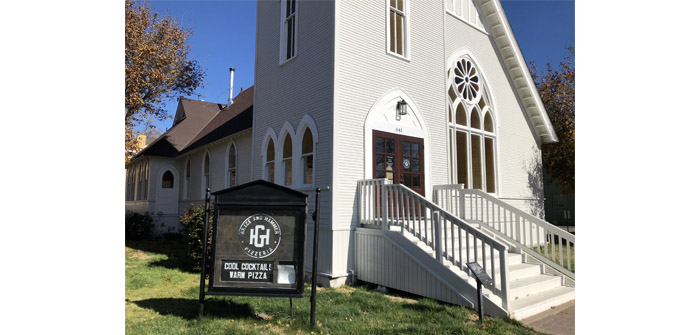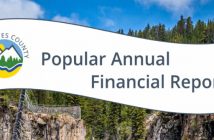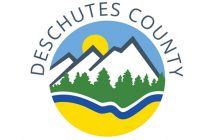(Grace and Hammer | Photo courtesy of the City of Redmond)
Diana Barker remembers when Redmond had just one flashing light. As a girl she rode her horse along the dry canyon, surrounded by nothing but sagebrush and juniper trees. A web of dirt roads connected the few thousand people who’d settled in the small town.
With Redmond’s population tipping 30,000 residents today, Barker, a principal broker for Windermere Real Estate, hardly considers it a small town anymore. Yet the community still holds on to its roots, fostering connections among families and friends reminiscent of those days long gone.
“People in Redmond are very grounded. It’s a family-oriented place where people are connected with each other,” Barker explained. “We will continue to grow because we have a quality of life here that can’t be replicated very many places.”
In a city where the population has more than doubled in the past 20 years — and is projected to add 1,000 more residents a year, landing the 2040 population at approximately 50,000 people — retaining a small-town atmosphere seems like a daunting task.
As the city’s managers and planners work to develop Redmond’s 2040 Vision and Comprehensive Plan, however, public feedback has been clear.
“Unequivocally, the dominant theme surfacing from public feedback is that everyone loves being ‘small town,’” stated Redmond Deputy City Manager John Roberts. “In turn, the foundation and guiding philosophy of the City’s draft Vision is that of retaining the small-town feel.”
The heart of such a distinguishing trait is the people, which includes city employees who exemplify the small-town feel in what they do in their departments every day, Roberts said.
“Although the Comp Plan is the lead planning document for the physical development of the community, the Vision transcends the planning department and is applicable to all the important projects going on among all the different City departments,” Roberts explained.
The inherent challenge, Roberts added, is for city employees to forge into the future with continued enthusiasm for a small-town approach to meeting the needs that are defined by substantial growth.
“We need to recognize what we want, value it and practice it in ways big and small while the proverbial tides of change roll into Redmond,” Roberts said.
Reinventing Downtown
While Redmond inevitably faces growing pains, there is a long history of planning for the future rather than getting caught having to play catch up. Forward thinking has allowed the city to stay ahead of challenges such as increased traffic and deteriorating roads. The highway 97 reroute more than a decade ago is a bold example of this enterprising mindset.
Redmond Mayor George Endicott remembers his mother expressing her fear of downtown.
“She was afraid to park on 6th Street,” Endicott said. “We needed to move traffic out of downtown, especially the truck traffic. People needed to be able to walk around downtown without breathing diesel and being afraid to walk across the street.”
Downtown became accessible after the 97 reroute, and although traffic levels have returned to previous numbers, those driving into downtown Redmond today are there by choice, not just to pass through.
Redmond’s Downtown Revitalization Project, which the Redmond Urban Renewal Agency launched in 1995 along with the creation of the Downtown Urban Renewal District, was spurred forward after the highway reroute in 2007-2008. Under the guidance of the Downtown Urban Renewal Advisory Committee, new streetscapes, facade improvements, the addition of a city-center park and updated water and sewer infrastructure brought phase one of the revitalization project to a successful conclusion, celebrated by city leaders and community members alike.
Phase two of the downtown revitalization project has initiated what many refer to as a renaissance of the ever-growing community.
“The Redmond Urban Renewal Agency is strongly focused on public/private projects at this stage of the life of the district,” explained Redmond Economic Development and Urban Renewal Program Manager Chuck Arnold. “Over the past year, urban renewal investments of $275,000 have leveraged over $1.7 million in project improvements in our commercial core. Over the same time period, the agency has helped with building improvements aiding the opening of 16 new businesses downtown.”
Culinary Choices Abound
One of the most recognizable transformations is Redmond’s restaurant scene, with the introduction of a plethora of new dining options.
“It’s changing the flavor of downtown,” said Jon Stark, senior director of Redmond Economic Development Inc. (REDI). “The innovation we’re seeing is happening somewhat organically. Competition is the best thing to improve any industry, so adding restaurants adds competition, which stimulates better quality and better experiences.”
For any city, having exceptional dining options for every palate can make a huge difference to its residents. Dan Mooney, owner of Mooney Marketing, moved to Redmond from Bend with his wife eight years ago; for some time after their move, the couple often felt compelled to venture south when they wanted to eat out. That’s not the case anymore.
“We have restaurants with great burgers, there are excellent steakhouses, amazing pizzarias, sushi … we have every option right here in Redmond now,” Mooney said.
Among the exciting new culinary options is the much-anticipated Becerra’s on 6th Bistro, which recently opened after the owners spent the past year renovating the century-old Dolliver Hotel Annex. Described as an American bistro with a French influence, the restaurant’s refined menu presents a different dining option than previously available in Redmond.
Pizza aficionados can now test their taste buds at Grace and Hammer pizzeria and bar, also housed within a piece of Redmond’s historical architecture — the former First Presbyterian Church, which was built in 1912.
Perhaps the most noticeable renovation of a historical building boasting a new dining experience, The New Redmond Hotel by SCP features The Rooftop — serving up classic, locally inspired dishes and handcrafted cocktails with a 360-degree view from the roof of the tallest building in Redmond.
The hotel itself is in the final push of a two-year renovation toward a much-anticipated opening. The hotel, at SW 6th Street and Evergreen Avenue, was originally built in 1928 and is listed on the National Register of Historic Places. The revival of this historic property — which was part of the city’s downtown revitalization plan for a decade before the public-private partnership between the city and the developer came to fruition — is considered one of the most important projects in the downtown revitalization, with the hope that it will spark continued dedication to the downtown area among private business owners. The anticipated economic impact of the hotel, Arnold noted, is estimated at approximately $3 million annually.
“Many new projects including workforce housing and more restaurants are also planned,” Arnold said. “One of the goals of the Urban Renewal District is to help create the 18- to 24-hour environment downtown, where there is always something happening. New housing will contribute to that goal by adding people who live downtown. The success of the Odem Theatre, a new movie theatre downtown, has helped demonstrate the community’s desire for more evening activities. Next year, a live music and entertainment venue is planned to continue to build on that success.”
Getting Around Town
It’s not just the vibrant downtown scene, however, that appeals to residents like Mooney. Redmond’s accessibility is also key.
“My wife and I can ride our bikes anywhere in town; nothing is far,” Mooney said. “The dry canyon is super accessible by bike — or by walking or even snowshoeing — and you can grab it instead of the surface streets to go all the way from North to South or even to access downtown, where we love to walk around and look at all the cozy, old houses. Downtown has a special, vintage feel.”
Continued growth and exponential increases in traffic, however, necessitate updates to the city’s connectivity in some areas.
“In some ways we look like Neapolitan ice cream,” said Mayor Endicott. “When you look at it, we have residents on the right, retail in the middle and industry on the left. We have the canal and the railroad and the highway limiting access back and forth.”
The US 97 South Redmond Corridor Project began with preliminary studies in 2010, working to create solutions for the area of Redmond along Highway 97 south of downtown. A cooperative effort between the city and Oregon Department of Transportation, the project aims to introduce changes to the area’s traffic flow — such as adding signals and designated U-turn lanes — that will enhance corridor safety while supporting the economic viability of businesses in the area. Additionally, the project’s working concepts include creating new biker- and pedestrian-friendly routes connecting the east and west sides of the corridor.
“Dedicated to inclusivity, the city put together a Project Advisory Committee in order to collect a range of community input on the project’s proposed solutions,” said Scott Woodford, project manager.
Airport Expansion
Traversing the area may be increasingly challenging, but getting to and from the city certainly isn’t. Not only does Redmond sit at the crossroads of US Highway 97 and US Highway 126, but the city is home to the region’s only commercial airport.
Redmond Municipal Airport (RDM) has seen rapid growth over the past five years, marking a 100 percent increase in the number of passengers. Additionally, noted RDM Director Zachary Bass, the 2019 calendar year will break the one million passenger mark, and 2020 is expected to see 1.1 million passengers through the airport.
The airport’s increased traffic includes more frequent flights to current destinations offered by the same airlines as well as some airlines stepping into new destinations, including United’s seasonal flights to Chicago. The Chicago flights were successful this season, Bass said, prompting expectations that the airline will offer them again for a longer season next year, and may consider adding them on a year-round basis.
RDM recently added Allegiant Air back into the lineup of air carriers. The airline, which had a five-year run before stopping its service out of Redmond seven years ago, has returned with year-round, twice-weekly flights to both Las Vegas and Phoenix-Mesa. The addition of Allegiant Air came shortly after RDM added Sun Country Airlines to its lineup, featuring two seasonal, weekly nonstop flights to Las Vegas.
Further increasing options, Alaska Airlines will be adding daily flights to and from San Francisco, Los Angeles and San Diego beginning in January 2020.
Expansion projects at the airport include a newly completed ramp expansion that adds two commercial aircraft mainline parking spaces, taking the overnight capacity from nine to 11, and construction of a new 42,000-square-foot operations building to replace the 20-year-old, 7,000-square-foot building.
Construction has just started on the new building, which will house the airport’s specialized aircraft snow removal equipment all in one location.
“The consolidation will allow us to more efficiently fight bad weather,” Bass explained, noting the projected completion as October 2020.
Additional upcoming plans for the airport include a parking lot extension, constructing a rental car quick turnaround and adding a third TSA lane dedicated to those enrolled in TSA PreCheck. They’ll also begin a planning process for terminal expansion that Bass said is anticipated will be needed in the next three to five years.
“The broader picture is there’s been $100 million invested in the airport over the past 10 years — mostly federal funding for runway expansions, this year there’ve been $25 million in projects and over the next 10 years we expect to see another $150 million in projects,” Bass noted.
But despite the record growth, Bass said they never stop considering what makes the Redmond airport where people want to fly out of.
“People love the small-town feel, the friendliness and the cleanliness,” he said. “We want to maintain that feeling, so we spend money on projects, but focus on that experience.”
Putting Manufacturing on the Map
While Redmond is the geographical center of Central Oregon, truly “The Hub,” sitting equally distant from Madras, Sisters, Prineville and Bend, it is also considered the hub of manufacturing.
The city’s manufacturing employment has seen substantial growth over the past five years, outpacing the state and national averages. The largest local manufacturing employers were little known just a decade ago, in fact, explained REDI’s Jon Stark, offering BasX as an example.
“When BasX opened its doors in 2014 in Redmond, they had about 20 employees; today they employ well over 100,” Stark said. Composite Approach has also experienced quick growth, employing about a dozen employees at its start and nearly 60 today.
“These are examples of the types of companies that have found Redmond a valuable place to grow and expand their businesses,” Stark reflected. “REDI is working with 23 projects presently, which includes 11 that are local businesses looking to expand, and 12 businesses in the final decision-making process to move their business to Redmond. Of those, 20 are in the manufacturing industry, and if they all become a reality, they will add 500 new jobs to this sector.”
The growth in living-wage job opportunities has shifted the balance and today, Stark said, Redmond imports 500 more workers than it exports in the region.
“A lot of people used to live in Redmond but work in Bend. Now, people are commuting to Redmond from Bend because we have so many opportunities,” he said.
“Companies can come here and grow thanks to affordable land and lease rates, a low cost of operations — in part due to low power cost — and a highly skilled workforce,” Stark explained. “Add to that the support of local government and the community, and now you have Redmond as the region’s manufacturing hub.”
A People-Driven City
Its business-friendly nature is just one of Redmond’s attributes that Stark credits for the city’s authenticity.
“Redmond is very authentic,” Stark said, borrowing a term coined to describe the city by one of his predecessors in City Hall. “From its people to the experience … you feel it in the grocery store, when you pick the kids up at school, at Friday night football games, at the parks … anywhere out in public. Redmond still has that small-town charm, and it has held on to it from 13,000 people to 30,000.”
So can it hold on to it from 30,000 to 50,000? Stark believes so.
“It’s simply based on the will of the people to keep it that way,” he said.
Eric Sande, executive director of the Redmond Chamber of Commerce and CVB, agrees and has no doubt the city will be able to retain what he describes as a “hometown” feel.
“People move here for what Redmond is, not to change it,” Sande said. “It’s a lifestyle choice. We’re family-oriented, our neighborhoods are connected through parks and there is a sense of place, of home, of belonging and of neighbor watching out for neighbor.”
With 850 members, the Chamber facilitates a lot of community connections, something that even after 20 years with the organization, Sande said he witnesses each week during their Coffee Clatter gatherings.
“It’s incredible to see the networking and connections that happen,” he said. “People appreciate knowing who they are doing business with here. There is a sense of quality and fairness; everyone is cautious and courteous because they know one another outside of business interactions. Someone may be your plumber one minute and cheering next to you on the sideline at your kids’ soccer game the next.”
Sande also sees his hometown as extremely generous.
“The volunteers make this community tick,” he said. “It is amazing to me how many worthy causes there are, and yet the need is always met.”
Volunteerism is an ideal way to stay up on what’s happening in the community, explained Mooney, who sits on the Chamber board and volunteers for the local police department. Participation on local committees is another way to create connections and have a say in community decisions, he added, noting that he is on the Redmond Committee for Art in Public Places (RCAPP).
Redmond has experienced a monumental growth in the arts in recent years. In line with what is essentially an art revolution, RCAPP has contributed more than 40 pieces of permanent public art pieces, which are installed throughout the city, as well as nearly 20 additional pieces that are rotated as part of Art Around the Clock.
A new nonprofit, the Dry Canyon Arts Association, joined the art scene this year, aimed at bringing artists and art appreciators together. The group is working toward securing funds to create a community arts and cultural center where people can take classes, see performances and view rotating art installments.
That sense of community spirit is what nearly every conversation about Redmond centers on. The question, “Why Redmond?” inevitably prompts the same answer.
“It’s the people,” Mayor Endicott declared.
The city’s managers and planners don’t take that fact for granted. Recognizing that it’s the people who make Redmond what it is, the city is steadfast in its commitment to gathering public input as it looks toward the future.





2 Comments
Beautiful job! I am a Redmondite and a communications professional and I appreciate your great portrayal of our community, Kari!
Any chance we can stop advertising our wonderful city so it doesn’t become over populated and lose that homelike feel?
Bend exploded and now look at it, Boise is on the same path. There are currently over 3000 Airbnb places in bend, if you add up the homes built over the last 9 years since the recession it matches those numbers.
Let’s quit pushing locals out of their homes, out of the town they helped build and focus on making it a better environment for more than just investing.